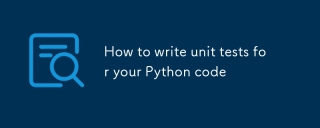 Backend Development
Backend Development Python Tutorial
Python Tutorial Building software firewalls and intrusion prevention systems using Python
Building software firewalls and intrusion prevention systems using PythonBuilding software firewalls and intrusion prevention systems using Python
With the rapid development of network technology, network security problems are becoming more and more serious. Intruders use various means and vulnerabilities to attack and invade network systems, causing huge losses to enterprises and individuals. In order to effectively deal with this challenge, building software firewalls and intrusion prevention systems has become one of the important tasks in today's Internet security field. Python is a powerful and easy-to-use programming language that can be used to build such systems.
Software firewall is a security device that filters network traffic and is used to monitor and control data packets transmitted over the network. It checks incoming and outgoing packets and blocks non-compliant packets from entering the protected network based on a preset set of rules. Python provides a series of network programming libraries and tools that can be used to implement the core functions of software firewalls.
First of all, we can use Python's socket library to monitor data packets in network transmission. This library provides functions for creating socket objects that we can use to listen for packets on specified ports. By parsing the header information of these packets, we can obtain important network information such as source IP address, destination IP address, protocol type, etc.
Secondly, Python's scapy library is a powerful network packet processing tool, which can be used to construct and parse network packets. We can use this library to analyze the contents of data packets to determine whether they contain malicious code or illegal operations. When a suspicious data packet is detected, we can call the operating system's firewall command through Python's subprocess library to intercept or discard the malicious data packet.
In addition, Python also provides some third-party libraries for network security, such as PySnort and PyNIDS. Based on open source projects such as Snort and libnids, these libraries provide easy-to-use interfaces to detect and intercept intrusions. By using these libraries, we can quickly build an effective intrusion prevention system.
In addition to building software firewalls and intrusion prevention systems, Python can also be used to manage network devices and analyze log data. For example, we can use Python to interact with the management interface of network devices to configure, monitor and troubleshoot the devices. At the same time, Python also provides various log processing libraries and algorithms, which can be used to analyze network log data and discover and predict potential security threats.
When using Python to build software firewalls and intrusion prevention systems, you need to pay attention to some security issues. First, we need to implement strict input validation and filtering on Python code to prevent malicious users from bypassing the defense system through injection attacks. Secondly, we need to conduct regular security reviews and vulnerability scans on Python code and fix related security vulnerabilities in a timely manner.
In general, using Python to build software firewalls and intrusion prevention systems can help us effectively deal with network security threats. Python provides a wealth of network programming libraries and tools that can meet the various functions required to build firewalls and intrusion prevention systems. However, when we use Python to build such a system, we also need to pay attention to security issues to ensure the stability and reliability of the system.
The above is the detailed content of Building software firewalls and intrusion prevention systems using Python. For more information, please follow other related articles on the PHP Chinese website!
 How to write unit tests for your Python codeAug 30, 2025 am 06:58 AM
How to write unit tests for your Python codeAug 30, 2025 am 06:58 AMWriting unit tests using Python's built-in unittest framework or a simpler pytest library can effectively verify function behavior, simplify debugging and improve code maintainability; first choose unittest or install pytest, create test files and write test methods starting with test_, cover normal and boundary situations, keep test independent, and use mock to isolate external dependencies. Finally, run tests through the pythontest_file.py or pytest command to ensure the quality of the code.
 How to automatically format Python code using black?Aug 30, 2025 am 06:51 AM
How to automatically format Python code using black?Aug 30, 2025 am 06:51 AMInstallBlackusingpip,conda,orpipx.2.Formatasinglefilewithblackyour_script.py.3.Formatmultiplefilesordirectoriesbyspecifyingthefolderpath.4.Use--checktoverifyformattingwithoutchanges.5.Use--difftopreviewchanges.6.Customizesettingsviapyproject.tomlforl
 Building Recommendation Engines with PythonAug 30, 2025 am 06:29 AM
Building Recommendation Engines with PythonAug 30, 2025 am 06:29 AMThe recommendation system is one of the core functions of websites and apps, and is mainly implemented through collaborative filtering and content recommendation. 1. Collaborative filtering is based on user behavior. If user A is similar to user B's interests, then recommend items that A likes but B has not touched to B; 2. Content recommendations are based on item characteristics, such as the type of movie, director and other information, and 3. In practice, mixed recommendations are mostly used to improve the effect; 4. Python has multiple recommendation libraries, such as scikit-surprise is suitable for the introduction to collaborative filtering, LightFM supports mixed models, implicit processes implicit feedback efficiently, and scikit-learn is used for feature processing in content recommendations; 5. Data preprocessing is crucial, including cleaning data and processing of sparse
 How to use conditional statements (if, elif, else) in PythonAug 30, 2025 am 06:00 AM
How to use conditional statements (if, elif, else) in PythonAug 30, 2025 am 06:00 AMConditionalstatementsinPythonuseif,elif,andelsetocontrolcodeexecutionbasedonconditions.1)Startwithiffollowedbyaconditionandacolon.2)Useelifforadditionalconditions,whichisoptionalandcanberepeated.3)Endwithelseifadefaultactionisneeded,whichrunsonlywhen
 How to read and write PDF files in Python?Aug 30, 2025 am 05:22 AM
How to read and write PDF files in Python?Aug 30, 2025 am 05:22 AMUse the pypdf library to read PDF files, extract text and metadata through PdfReader; 2. Use the fpdf2 library to create PDFs, add pages, texts, etc. through FPDF class and save them; 3. Use pypdf to merge, split or encrypt PDFs, and implement them through PdfWriter operations; 4. For scanned PDFs, combine pdf2image and pytesseract for OCR recognition, convert PDFs into images and then extract text. Summary: pypdf is used for reading and editing, fpdf2 is used for generation, OCR requires additional tools, PDF processing should be mainly generated and combined rather than directly editing, and task completion ends with a period.
 How to use break and continue in Python loopsAug 30, 2025 am 04:52 AM
How to use break and continue in Python loopsAug 30, 2025 am 04:52 AMThe break statement is used to exit the loop immediately. The code after the loop is executed is suitable for termination when a match is found or the condition is met; 2. The continue statement is used to skip the remaining code of the current iteration and directly enter the next iteration, suitable for filtering invalid data or avoiding processing under specific conditions; 3. The two can be used in the same loop, such as skipping even numbers and terminating the loop when encountering 7; 4. The actual application includes skipping the null value when reading user input and exiting the loop when entering "done". These two control statements make the loop more flexible and efficient.
 How to connect to a SQL database in PythonAug 30, 2025 am 04:04 AM
How to connect to a SQL database in PythonAug 30, 2025 am 04:04 AMTo connect to the SQL database, you need to select the appropriate driver and manage the connection correctly: SQLite uses built-in sqlite3, MySQL can use PyMySQL, and PostgreSQL can use psycopg2; after installing the corresponding driver through pip, use the connect function to establish a connection, create a cursor to execute queries, and ensure that the connection is closed; it is recommended to use a context manager to automatically handle transactions, and the production environment should use connection pools and environment variables to store sensitive information. Large projects can use ORMs such as SQLAlchemy to simplify operations, and ultimately achieve stable and reliable database interaction.
 Get USDA nutrition data using Python API: Break the limit of 50 recordsAug 30, 2025 am 04:03 AM
Get USDA nutrition data using Python API: Break the limit of 50 recordsAug 30, 2025 am 04:03 AMThis article describes how to use Python to access the USDA’s (USDA) Nutrition Data API and address the limitation of only 50 records being available by default. By analyzing API documentation and understanding the paging mechanism and parameter settings, we will learn how to iterate through all pages, get the complete data set, and use it for subsequent data analysis and processing. This article provides detailed code examples to help readers get started quickly.


Hot AI Tools

Undress AI Tool
Undress images for free

Undresser.AI Undress
AI-powered app for creating realistic nude photos

AI Clothes Remover
Online AI tool for removing clothes from photos.

Clothoff.io
AI clothes remover

Video Face Swap
Swap faces in any video effortlessly with our completely free AI face swap tool!

Hot Article

Hot Tools

SublimeText3 Mac version
God-level code editing software (SublimeText3)

SublimeText3 English version
Recommended: Win version, supports code prompts!

Zend Studio 13.0.1
Powerful PHP integrated development environment

ZendStudio 13.5.1 Mac
Powerful PHP integrated development environment

MantisBT
Mantis is an easy-to-deploy web-based defect tracking tool designed to aid in product defect tracking. It requires PHP, MySQL and a web server. Check out our demo and hosting services.





